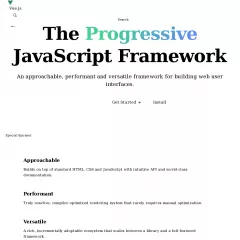Vue.js 
Vue.js is used by 0.22% of sites
Official Website
https://vuejs.orgCategory
JavaScript Frameworks
Vue.js is a progressive JavaScript framework for building user interfaces. It is designed to be approachable, flexible, and easy to integrate into existing projects. Vue.js focuses on the view layer of an application and provides a reactive and component-based approach to building UIs. Here are some key aspects of Vue.js:
Reactive Data Binding: Vue.js utilizes a reactive data binding system, which allows developers to declare data properties in the Vue instance and bind them to the HTML template. Any changes to the data will automatically update the corresponding parts of the UI, ensuring a reactive and synchronized view.
Component-Based Architecture: Vue.js promotes a component-based approach to building applications. Components in Vue.js are self-contained and reusable UI elements that encapsulate their own logic and structure. This makes it easier to manage and organize complex UIs, as well as promote code reuse and modularity.
Template Syntax: Vue.js provides a simple and intuitive template syntax that allows developers to declaratively render the UI based on the data and component structure. The template syntax resembles HTML, making it easy to learn and work with, while also providing additional features such as directives and expressions for dynamic rendering and data manipulation.
Directives and Reactive Directives: Vue.js offers a set of built-in directives that enable developers to add behavior and manipulate the DOM within templates. Directives such as v-if, v-for, and v-bind allow conditional rendering, iteration, and dynamic attribute binding. Reactive directives like v-model enable two-way data binding between form inputs and data properties.
Computed Properties and Watchers: Vue.js provides computed properties, which are cached data properties that are derived from the original data. Computed properties are reactive, meaning they automatically update when the dependencies change. Additionally, Vue.js allows the creation of watchers, which enable developers to react to changes in specific data properties and perform custom logic when those changes occur.
Vue Router: Vue.js has an official routing library called Vue Router, which provides a routing system for building single-page applications (SPAs). Vue Router allows developers to define different routes, handle navigation, and dynamically load components based on the current route.
Vue CLI: Vue.js offers a command-line interface tool called Vue CLI, which helps developers scaffold and set up Vue.js projects quickly. Vue CLI provides a project template with a pre-configured build system, development server, and other necessary tools for efficient development.
Ecosystem and Community: Vue.js has a vibrant ecosystem and a large and active community of developers. It has a rich set of official and community-driven plugins and extensions that provide additional functionality and integration with other libraries and tools. The Vue.js community actively contributes to the development of the framework, provides support through forums and online resources, and organizes conferences and meetups.
Vue.js is widely adopted and used in various types of web applications, ranging from small projects to large-scale enterprise applications. Its simplicity, flexibility, and excellent documentation make it a popular choice for developers who want to create dynamic and interactive user interfaces.
Reactive Data Binding: Vue.js utilizes a reactive data binding system, which allows developers to declare data properties in the Vue instance and bind them to the HTML template. Any changes to the data will automatically update the corresponding parts of the UI, ensuring a reactive and synchronized view.
Component-Based Architecture: Vue.js promotes a component-based approach to building applications. Components in Vue.js are self-contained and reusable UI elements that encapsulate their own logic and structure. This makes it easier to manage and organize complex UIs, as well as promote code reuse and modularity.
Template Syntax: Vue.js provides a simple and intuitive template syntax that allows developers to declaratively render the UI based on the data and component structure. The template syntax resembles HTML, making it easy to learn and work with, while also providing additional features such as directives and expressions for dynamic rendering and data manipulation.
Directives and Reactive Directives: Vue.js offers a set of built-in directives that enable developers to add behavior and manipulate the DOM within templates. Directives such as v-if, v-for, and v-bind allow conditional rendering, iteration, and dynamic attribute binding. Reactive directives like v-model enable two-way data binding between form inputs and data properties.
Computed Properties and Watchers: Vue.js provides computed properties, which are cached data properties that are derived from the original data. Computed properties are reactive, meaning they automatically update when the dependencies change. Additionally, Vue.js allows the creation of watchers, which enable developers to react to changes in specific data properties and perform custom logic when those changes occur.
Vue Router: Vue.js has an official routing library called Vue Router, which provides a routing system for building single-page applications (SPAs). Vue Router allows developers to define different routes, handle navigation, and dynamically load components based on the current route.
Vue CLI: Vue.js offers a command-line interface tool called Vue CLI, which helps developers scaffold and set up Vue.js projects quickly. Vue CLI provides a project template with a pre-configured build system, development server, and other necessary tools for efficient development.
Ecosystem and Community: Vue.js has a vibrant ecosystem and a large and active community of developers. It has a rich set of official and community-driven plugins and extensions that provide additional functionality and integration with other libraries and tools. The Vue.js community actively contributes to the development of the framework, provides support through forums and online resources, and organizes conferences and meetups.
Vue.js is widely adopted and used in various types of web applications, ranging from small projects to large-scale enterprise applications. Its simplicity, flexibility, and excellent documentation make it a popular choice for developers who want to create dynamic and interactive user interfaces.